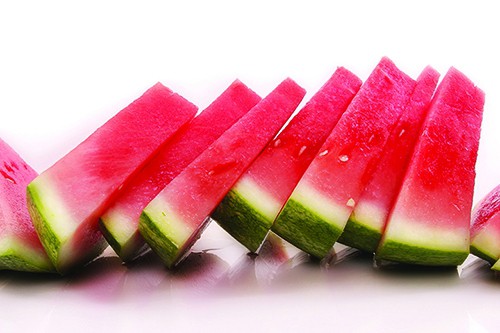
Refreshing watermelon is the most-consumed melon in the United States, followed by cantaloupe and honeydew. Thought to have originated in the Kalahari Desert of Africa, watermelon’s official name is Citrullus lanatus of the botanical family Cucurbitaceae. It is a cousin to cucumber, pumpkin and squash.
In the Kitchen
Of the more than 50 varieties of watermelon, the most common kinds are seeded, seedless, picnic, icebox and yellow or orange-fleshed. They typically range in weight from about 5 pounds to more than 30 pounds.
Seedless watermelons, which first were produced commercially in the 1990s, tend to be less sweet than seeded. In actuality, seedless watermelons have tiny, undeveloped, easily digested seeds, so while they aren’t technically seedless, there aren’t any large seeds to spit or pick out. Picnic watermelons are the large, red variety many of us picture when we think of watermelon. They typically range in size from 15 pounds to 45 pounds. Icebox watermelons are tiny and more suited to serving just a few people. They tend to grow to anywhere between 5 pounds and 15 pounds. Although red-fleshed watermelons may be the most familiar to shoppers, yellow and orange varieties also are available. The color of the watermelon skin and rind can vary as well, from rich green to yellow.
When selecting a whole watermelon, look for a firm, symmetrical melon that is heavy for its size and free of bruises, dents and gashes. Ideally, the underside of watermelon should have a yellow spot from where it sat on the ground. When buying pre-cut watermelon, avoid pieces that look slimy or mealy.
Watermelon can be enjoyed raw, either on its own cut into wedges or cubes, or added to other dishes. Its high water content makes it ideal for blending into a beverage or cold soup, such as gazpacho. Watermelon wedges also can be grilled to make a fruity side dish. A little salt brings out the natural sweetness.
In the Clinic
Evident from its name, watermelon is very hydrating — it is about 92 percent water. That high water content also means it is fairly low in calories: a one-cup serving contains 46 calories. In addition, watermelon contains about 17 percent of the daily value for vitamin A and 20 percent of the daily value for vitamin C, both of which are essential for immune system function and healthy skin.
A one-cup serving of watermelon also boasts 170 milligrams of potassium, a mineral needed for countless body processes. Although tomatoes tend to get the most attention when it comes to lycopene, watermelon contains 40 percent more of this antioxidant than raw tomatoes. Lycopene gives certain fruits and vegetables a bright red color and has been studied for its possible role in reducing risk of conditions such as cancer, cardiovascular disease and macular degeneration.
In Quantity
Because it requires minimal cooking, watermelon works well in salads, cold soups and blended beverages. A whole watermelon with the rind intact can be stored in the refrigerator, if possible, or at room temperature for a week. Before cutting, it is important to wash the outside of the rind to prevent potential spread of foodborne illness. Cut watermelon should be wrapped tightly (cubed pieces should be stored in an airtight container) and refrigerated for up to four days. Firm, ripe watermelon can be cut in slices or cubes and frozen to use in smoothies — it also is sold this way in the frozen fruit aisle. However, frozen watermelon may have a mushy consistency when thawed.
Jessica Cording, MS, RD, CDN, is a registered dietitian and writer in New York City. She is a Stone Soup blogger and author of jessicacordingnutrition.com.
Pickled Watermelon Rinds
Developed by Natalie Rizzo
Servings: 12
Serving size: ½ cup (140 grams)
Prep time: 30 minutes
Cooking time: 12 minutes
Ingredients
- 5 cups watermelon rind with pink flesh removed (from a 4-pound watermelon)
- 1 cup (240 milliliters) apple cider vinegar
- 1 cup (240 milliliters) water
- 1 cup granulated sugar
- 1 star anise
- 1 tablespoon pickling spice
- 1 tablespoon fine sea salt
Instructions
- Using a vegetable peeler or paring knife, remove the tough green outer layer from watermelon rinds and discard. Cube watermelon rinds. In a large saucepan, combine vinegar, water, sugar, star anise, pickling spice and sea salt. Bring to a boil. Place watermelon rinds in boiling solution and cook for 2 minutes. Reduce heat to low and simmer uncovered for 10 minutes. Set aside to cool for about 1 hour.
- The liquid mixture can still be warm when poured in the storage container, but it should not be hot. Once cool, place the watermelon rind mixture in an airtight container and refrigerate for up to 2 weeks. Wait until the watermelon rind is cold before tasting. It should have a crunchy consistency and be a translucent color.
NUTRITION PER SERVING:
Food & Nutrition is dedicated to providing accurate information to its readers. We are unable to calculate nutrition information for this recipe due to lack of available credible nutrition information for watermelon rinds and multiple variables affecting sugar and sodium absorption during the pickling process.










